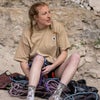Controversial Call at USA Climbing Team Trials Sparks Debate
Was Adriene Akiko Clark "robbed" of gold, or are “rules rules”?
Heading out the door? Read this article on the new Outside+ app available now on iOS devices for members! Download the app.
The USA Climbing Team Trials and Paraclimbing National Championships took place this past week at Sportrock Rio in Gaithersburg, Maryland. The six days of action were filled with highs and lows, ending with complete National Team rosters for the pending World Cup and Paraclimbing seasons. (Replays of all final rounds are available on Outside Watch.)
The women’s Lead final round, however, has drummed up significant debate. Denver’s 19-year-old Adriene Akiko Clark made the high point—with a score of 38+—followed by Olivia Ma and Annie Sanders, who would have received scores of 36+ and 36, respectively. However, none of the women clipped the draw hanging near the 36th hold, and because the chief routesetter had ruled it impossible to make the clip after passing the 36th hold, all of the competitors’ scores were paused at hold 36. (Their scores would have resumed if they’d managed to complete the clip regardless of what hold they clipped from.) Due to a countback to semifinals, Akiko Clark was awarded the bronze, while Sanders took home gold and Ma was awarded silver.
No one was satisfied with the ruling; all three women considered boycotting the podium, but refrained from doing so to avoid repercussions. Sanders in particular risked getting a red card—which would have revoked her eligibility for the season as she’d already been yellow-carded earlier in the competition for forgetting her bib. After the competition she gave Akiko Clark her medal.
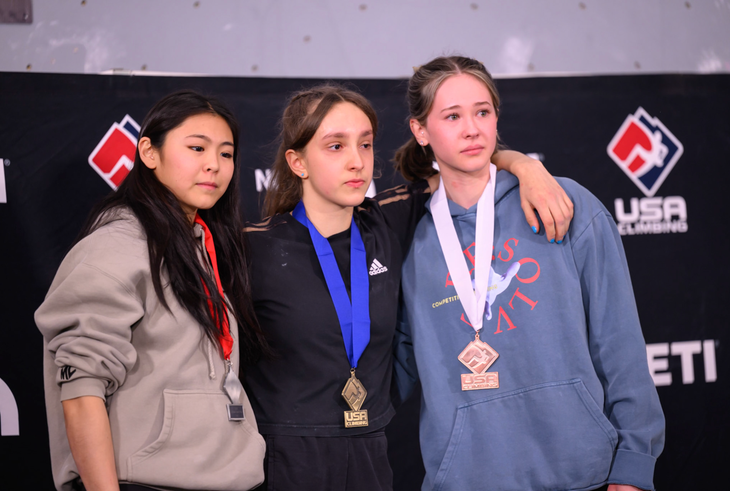
“Annie was probably crying the most,” says Ryan Arment, coach to Akiko Clark and longtime routesetter. “The honor all the women showed for the competition was really impressive.”
Akiko Clark lost out on a title as well as World Cup spots and funding; the third-place ranking put her into an alternate and unfunded position on the National Team. “I’ve been involved in USA climbing for about 15 years now,” says Arment. “I watch every competition, and I’m always the first to back up the routesetters and organizers. But in this case, I feel they really fucked it up. I feel compelled to say that in many other federations, this wouldn’t have been the ruling. They would have seen how it went down and would have ignored the routesetting assignment because it’s not practical. What happened at the trials was not a practical expression of competition.”
The Rules and Analysis
On Instagram, spectators widely questioned the decision. Several commenters asked why the 36th hold had not been demarcated with an X, which, according to USA Climbing rules, would have indicated it was the last possible clipping hold. But these criticisms fall short, because X’s are used only when safety is the primary concern. In this case, the ruling centered around the idea that competitors cannot skip clips.
Historically, a clip was deemed skipped if the lowest part of a climber’s body passed the draw, at which point their attempt was terminated. In 2020, the rule changed so that the competitor’s attempt was ended if they could no longer touch the draw with their hand. Most recently, in 2021 USA Climbing adapted its rules to align with those of the IFSC. Rule 7.11.2 (b)(iv) states that the “scoring of a competitor’s attempt will be paused at the last hold marked on the Topo from which the Chief Routesetter deems it possible to clip any unclipped Protection Point… unless or until the relevant Protection Point has been clipped.” In a sense, this latest iteration is the most flexible, as it allows competitors to find the correct position rather than get called down. In other words: if Akiko Clark, on hold 38, had managed to reach down and clip the draw at hold 36, she would have proved the routesetters wrong and her progress above hold 36 would have been counted. But since she didn’t clip, her score count was paused at hold 36.
View this post on Instagram
It’s worth noting, however, that it was not immediately clear that competitors would have needed to clip from the 36th hold, and judging from each of their body positions, it would have been a very difficult clip to make. “Annie said that all of the girls who previewed with her—including Adriene and Olivia—read hold 40 as likely being the best hold to clip from,” says Jack Sanders, father of 16-year-old Annie. He added that they saw it was possible to clip sooner, say from hold 33, but clipping higher seemed like the most efficient option.
There is another rule—section 1.9.1 a—worth understanding. For clarity, it may be abbreviated as: “Notwithstanding other rules within this Rulebook, the USA Climbing CEO, in consultation with the Event Organizer and Jury President of the affected competition, has the authority and discretion to modify competition formats in circumstances where an error has occurred that, without the exercise of such discretion, would materially undermine the integrity of a round or the competition.” Because all the competitors read the route differently than the setter, some feel that the Jury President could have amended the stop hold to be 40 rather than 36.
“Those girls are extremely flexible,” says Arment. “The routesetter is a 170-pound, six-foot-tall man, not a 110-pound, five-foot-four female, right? I’ve worked with all those girls before and they’re constantly breaking beta. There’s no world in which I think the argument that they couldn’t have clipped from a higher position is really honoring the athletes; if anything, it is putting up unnecessary guards.”
Competitive climbing’s rule systems will always feel unfair to someone. The comp climbing world has, for example, accepted the current tops/zones style of scoring boulding in spite of its limitations. If, in a finals round, you had a competitor who topped two boulders and reached the last hold on each of the other two boulders, and another competitor who topped three boulders but couldn’t get off the ground on the fourth, then the second competitor would win. But if our scoring system for bouldering was based on holds-gained rather than tops and zones, then the first competitor would win. These structural decisions dictate results, but they also steer perceptions of what competition climbing is and how it works. When those two ideations clash, the platitude “rules are rules” stops serving us, because kids who feel cheated may give up on participating.
“The world is not black and white,” says Arment. “You have to accept that things are going to be complicated. And you have to allow emotion to influence your objective observations. In this case, the observation is that this rule doesn’t support what we all saw. And that’s causing everyone to feel that the score is incorrect. You need to weigh ‘How do I feel’ versus ‘What is the objective rule?’”
USA Climbing Jury President Mike Sprague spoke with Climbing, saying, “In any sport, it’s possible for scores and ranking that properly adhered to the rules to not reflect perceived performance. Those situations are unfortunate; however, it would be inappropriate to change or ignore rules during a competition in order to reward perceived performance. Officials are assigned the responsibility of implementing the rules in a fair, consistent, and unbiased manner. Weighing the opinion of coaches, competitors, and/or spectators higher than that of officials would contradict the idea of sport.
“If, for example, another climber had made the clip in question and fell after controlling hold 36, I don’t think we would be having this conversation. Our perception of performance would likely be different: Adriene climbed further, but she didn’t take the time and energy to make the clip like the other climber did.”
Climbing reached out to several IFSC judges to get their takes but has yet to hear back. This story will be updated if they weigh in.
***
The other rounds at the Team Trials went comparatively smoothly. In front of his hometown, Noah Bratschi won the men’s speed. Emma Hunt, who has already qualified for the Paris 2024 Games, set a new National Speed record with the time of 6.54 seconds, while Sophia Curcio took gold. In a surprising women’s Bouldering final, former National Champion Melina Costanza missed the podium, finishing in fifth place, while darkhorse Helen Gillet, from Cambridge, took first. On the men’s side, 16-year-old Hugo Hoyer took first place, followed by Dillon Countryman and Ben Hanna. In men’s Lead, 16-year-old Declan Osgood took first, followed by Hoyer and Hanna.
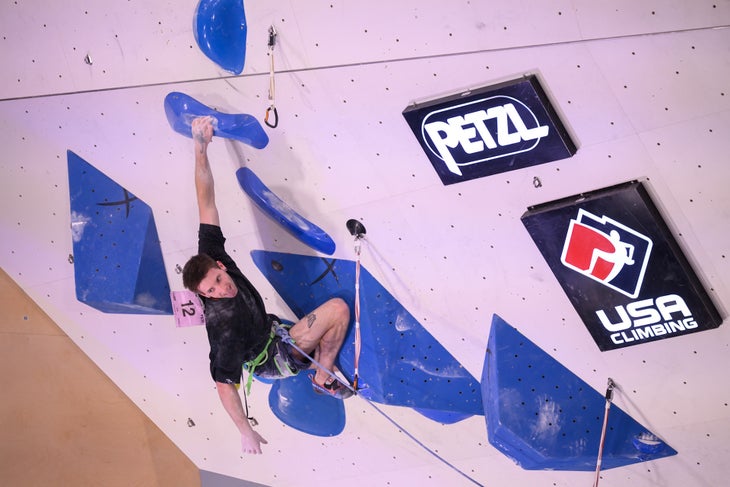
Former Paraclimbing World Cup gold medalist Brian Zarzuela took first place in Men’s AU2, as did Maureen “Mo” Beck. Another World Cup gold medalist, Benjamin Mayforth, took bronze in Men’s RP2. Veteran competitor Amy Mullins placed third in Women’s B3. Melissa Ruiz, who won the World Cup in Salt Lake City last year, took good Women’s RP1. The top three athletes from each category earned a spot on the National Paraclimbing Team.
Full results from the Trials and Paraclimbing National Championships can be found here and here.
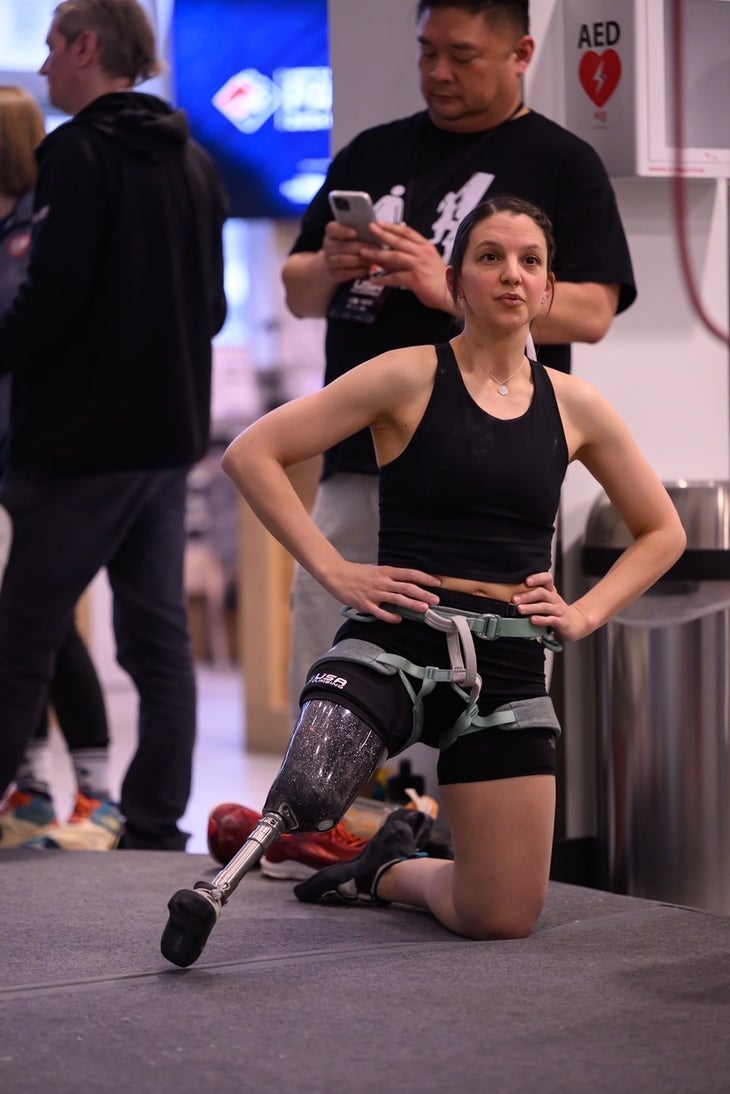
Results and National Teams
Speed
Women’s Speed Podium:
- Sophia Curcio
- Kaitlyn Bone
- Liberty Runnels
Men’s Speed Podium:
- Noah Bratschi
- Richard Li
- Thomas Lin
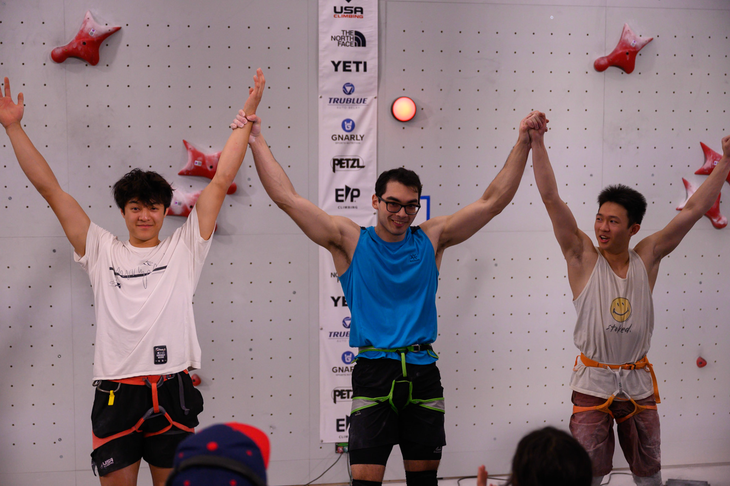
2024 Speed National Team:
Emma Hunt
Piper Kelly
Sophia Curcio
Kaitlyn Bone
Sam Watson
John Brosler
Zachary Hammer
Noah Bratschi
Lead
Women’s Lead Podium:
- Annie Sanders
- Olivia Ma
- Adriene Akiko Clark
Men’s Lead Podium:
- Declan Osgood
- Hugo Hoyer
- Ben Hanna
2024 Lead National Team:
Kyra Condie
Melina Costanza
Kylie Cullen
Natalia Grossman
Brooke Raboutou
Annie Sanders
Colin Duffy
Jesse Grupper
Hugo Hoyer
Declan Osgood
Bouldering
Men’s Boulder Podium:
- Hugo Hoyer
- Dillon Countryman
- Ben Hanna
Women’s Boulder Podium:
- Helen Gillett
- Analise Van Hoang
- Nekaia Sanders
2024 Boulder National Team:
Kyra Condie
Melina Costanza
Kylie Cullen
Helen Gillett
Natalia Grossman
Brooke Raboutou
Annie Sanders
Dillon Countryman
Colin Duffy
Jesse Grupper
Hugo Hoyer
Paraclimbing
MB1
- Eris Skenderi
- Terry Hoddinott
- Hussain Kadhem
MB2
- Ahmad Seyar Rahimi
- Kevin Chao
MB3
- Chaz Misuraca
- Andrew Martinez
- Diego Kusnir
MAL1
- Tanner Cislaw
- Jake Frank
- Carlos Quiles
MAL2
- Ethan Zilz
- Gavin Nix
- Ronnie Dickson
MAU2
- Brian Zarzuela
- Trevor Smith
- Matthew Lynch
MAU3
- Shamus Boulianna
- Braden Shoop
- Derek Kenney
MRP1
- Elliott Nguyen
- Joshua Unterman
- Sunny Yang
MRP2
- Dennis Connors
- Brayden Butler
- Ben Mayforth
MRP3
- Ian Gleason
- Michael Prince
- Daniel Medina
M Youth
- Nathan Mckinley
- Watson Armstrong
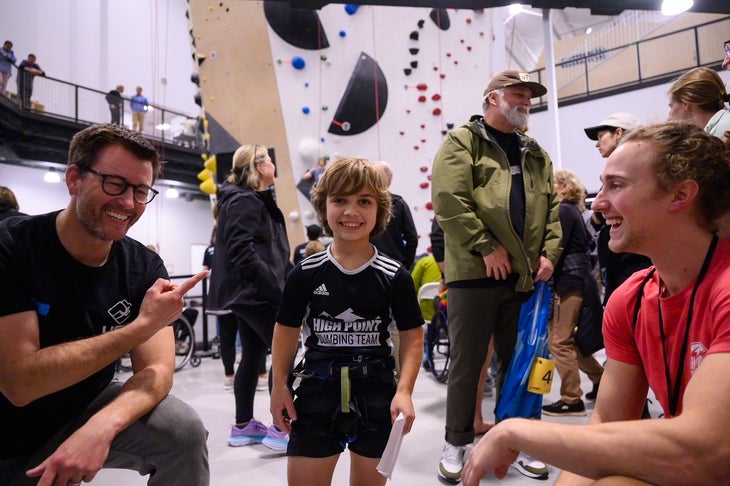
M Open1
- Evan Coutts
- Micahel Hoyt
- Tim Evans
M Open2
- Killian Rooney
- Wayne Lin
- Drew Coutts
WB1
- Emeline Lakrout
- Ashley Clburn
- Leah Grosjean
WB2
- Seneida Biendarra
- Addie Hugen
WB3
- Phoebe Barkan
- Linn Poston
- Amy Mullins
WAL1
- Carlie Cook
- Brittany Chadbourne
WAL2
- Mary Tankersley
- Cail Soria
- Morgan Loomis
WAU2
- Maureen Beck
- Eleanor Rubin
- Isabel Benvenuti
WAU3
- Ashley Pritchard
- Molly Ferris
- Kali Pauling
WRP1
- Melissa Ruiz
- Hannah Zook
- Olivia Conforti
WRP2
- Emily Seelenfreund
- Anna DeVries
- Caroline Winstel
WRP3
- Nat Vorel
- Laura Heaton
- Linsay Purcell
W Youth
- Mei Krause
- Audrey Chen
W Open1
- Janice Petzold
- Teresa Bennett
- Alpine Bird
W Open2
- Willow Wilcox
- Michelle Patten
- Sarah Bittermann
N Open
- Eliana Wallak
- Karin Haski
